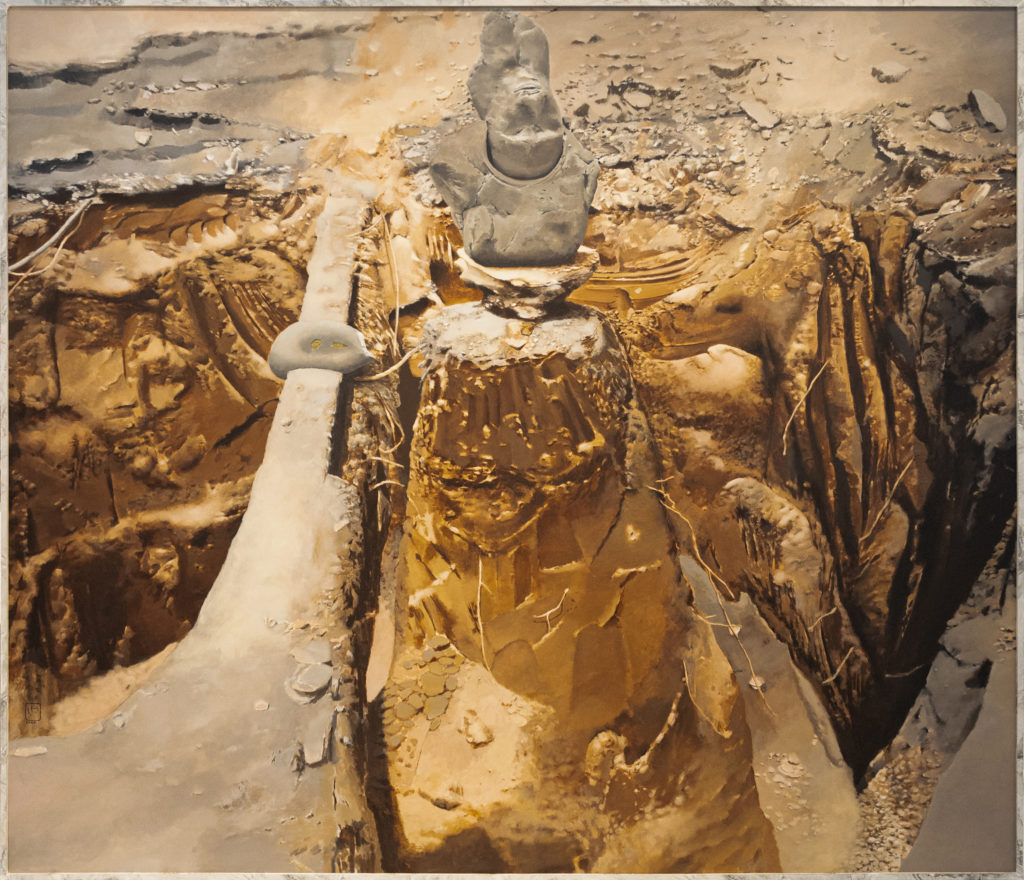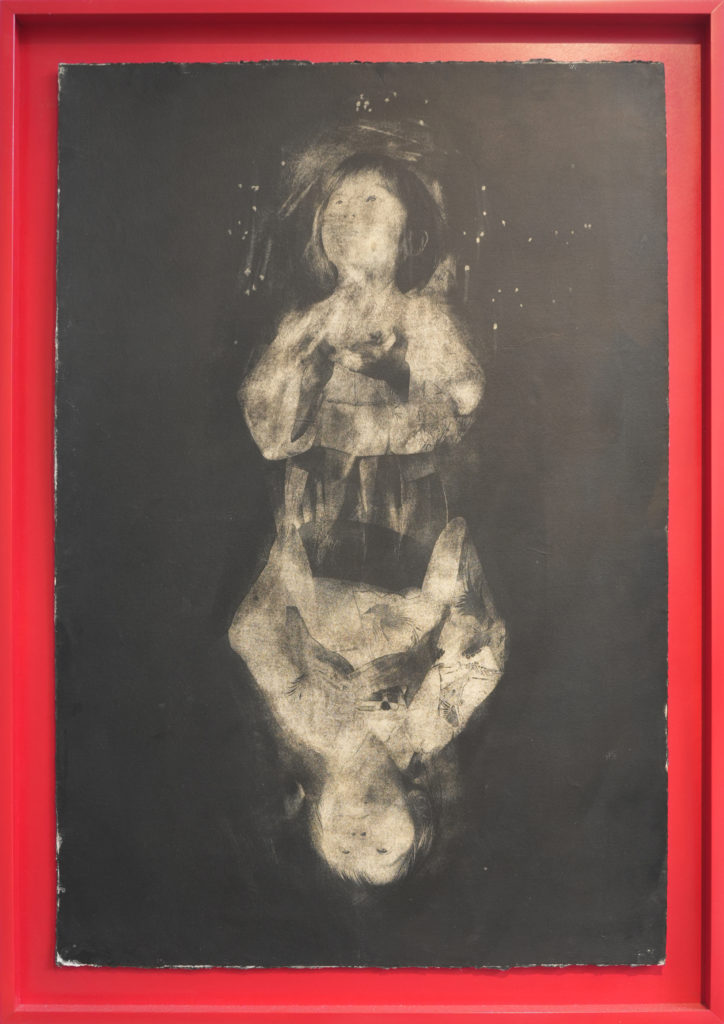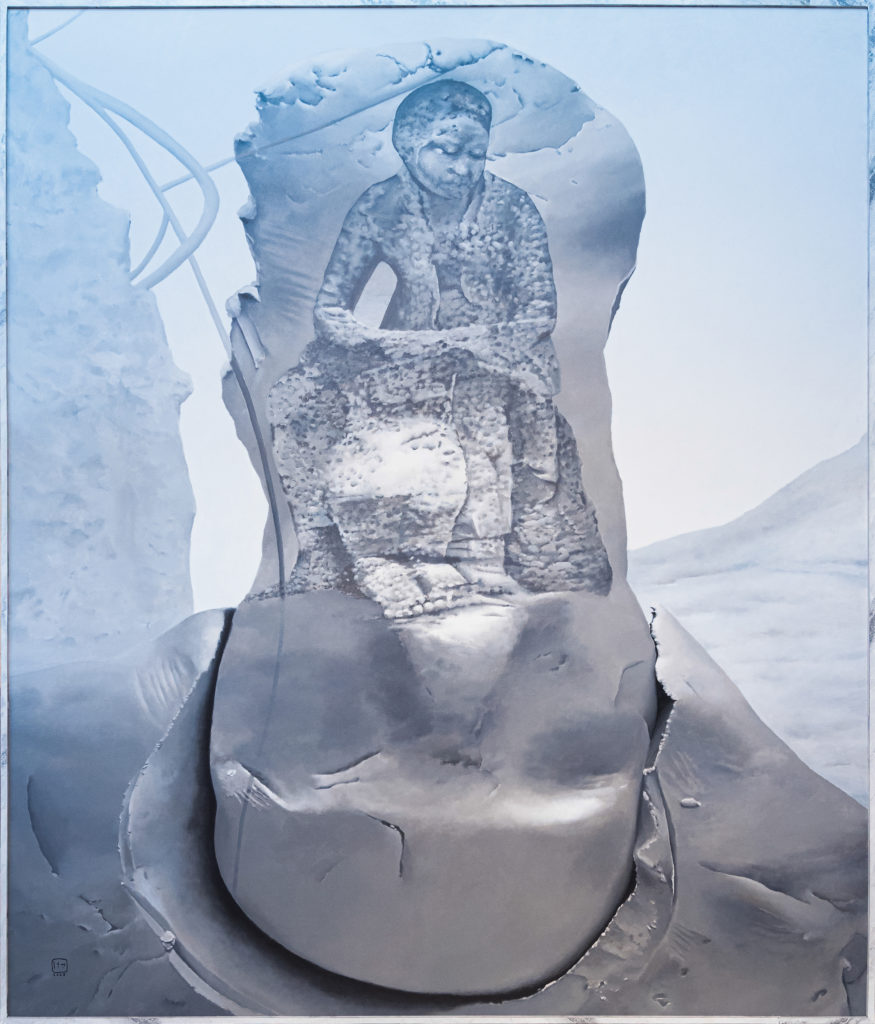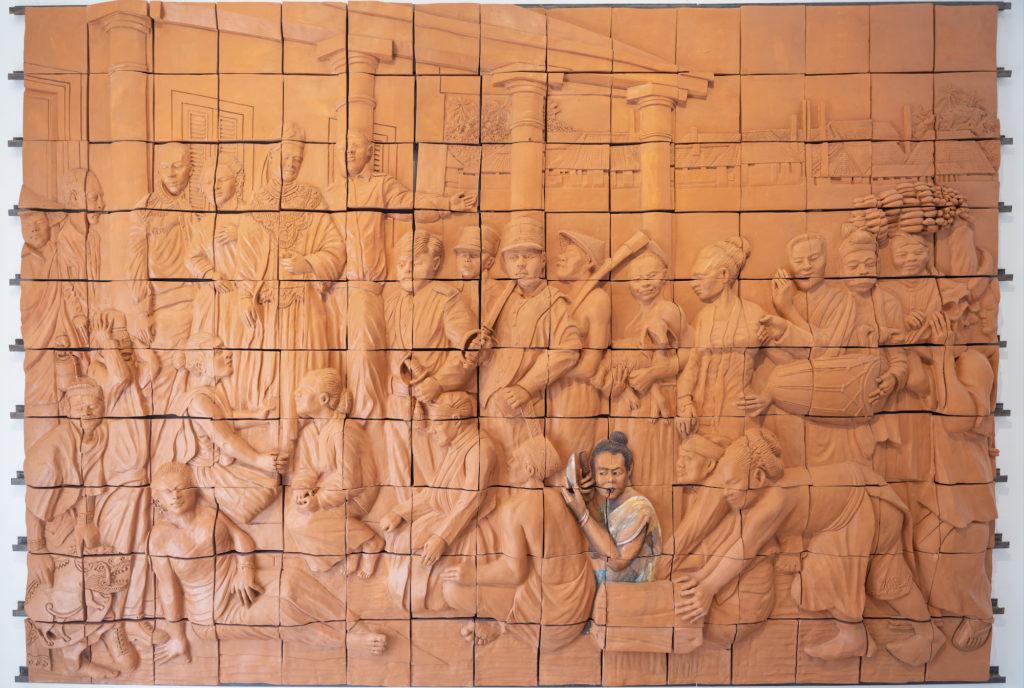by Vattaya Zahra //
(English version below)
Dans la ville de Surabaya, en Indonésie, l’exposition ARTSUBS 2024 offre un paysage diversifié de l’art contemporain indonésien, réunissant plus de 150 artistes sous le thème « Ways of Dreaming » dans le bâtiment historique Pos Bloc Surabaya du 26 octobre au 24 novembre 2024. Cette exposition s’étend sur 3 895 mètres carrés et présente plus de 200 œuvres d’art qui explorent la manière dont les rêves – personnels, collectifs et culturels – peuvent servir à définir l’identité indonésienne en constante évolution.
La question au cœur d’ARTSUBS est simple mais vaste : comment rêvons-nous face au changement, et que révèlent ces rêves sur les chemins que nous empruntons ensemble ? Sous le commissariat de Rambat en tant que directeur, Asmudjo J. Irianto en tant que directeur artistique et Nirwan Dewanto, l’exposition rassemble un échantillon représentatif de la scène artistique indonésienne. Dans cet article, nous nous entretenons avec Cecil Mariani, Handiwirman Saputra et Jatiwangi art Factory pour comprendre comment leurs œuvres embrassent ce thème sur plusieurs niveaux, transformant les rêves en formes de résistance, de souvenir et d’expression communautaire.

Cecil Mariani : « Dragons Praying to be Dove » (Dragons priant pour être colombe)
Cecil Mariani (née en 1978) présente une série introspective qui aborde les thèmes de l’ascendance, de la mémoire et de la perte dans le cadre de son projet en cours « Dragons Praying to be Dove » (Dragons priant pour être colombe). Son installation de quatre boîtes de néon, avec des matrices de film superposées et trois tirages photographiques alternatifs, parle de la création de sens post-traumatique – un processus qui, pour elle, est interne et résonnant. Les matrices de film superposées de Mariani semblent contenir des chuchotements d’histoires familiales et d’anxiétés culturelles, abordant les thèmes de la perte et du souvenir. Pour Mariani, la création d’images est plus qu’une simple représentation ; elle devient un rituel de connexion avec les ancêtres, un dialogue sur la nature de l’identité dans un paysage culturel en mutation.
Interrogée sur le thème « Ways of Dreaming », Mariani déclare : « Les rêves sont des matrices que nous fabriquons »; ils explorent la manière dont nos identités sont construites et déconstruites par la mémoire collective et l’histoire personnelle. À travers ses séries photographiques, elle coud ces rêves dans des récits visuels avec des idées de survie, de surnaturel et de « l’autre synthétique ». Son travail suscite une réflexion sur la manière dont nous héritons des rêves et les réimaginons, en utilisant l’image et la mémoire comme monnaie d’échange pour se réapproprier des identités culturelles façonnées à la fois par l’absence et la présence.

Handiwirman Saputra : « Sari Tanah » (Essence de la Terre)
Handiwirman Saputra (né en 1975) présente à ARTSUBS « Sari Tanah » (Essence de la Terre), une série fondée sur son engagement permanent à l’égard des éléments naturels et des thèmes spirituels. Le travail de Handiwirman s’inspire des versets du Coran décrivant la création de l’humanité à partir de l’argile, un concept qu’il développe grâce aux interprétations du Dr Nadiah Thayyarah dans le livre « Mausu’ah Al I’jaz Qurani » (Les miracles scientifiques dans le Coran). Ce fondement de la terre en tant qu’origine devient un moyen pour Handiwirman de réfléchir à l’existence, à la création et aux cycles qui façonnent l’humanité. Créée à partir de différents types de sol, « Sari Tanah » présente des formes humaines sans vie, censées évoquer le lien entre la terre et l’existence humaine.
Pour Handiwirman, l’acte de rêver est « l’une des graines plantées dans la vie », une forme d’investissement spirituel qui reflète le potentiel de la vie et ses limites. À travers « Sari Tanah », Saputra positionne le rêve comme une force génératrice enracinée dans la spiritualité, un contrepoint au détachement rapide de la société moderne vis-à-vis de la nature. Son travail nous rappelle l’interconnexion de toutes les formes de vie et incite les spectateurs à renouer avec les origines et les cycles qui nous soutiennent.

Jatiwangi art Factory : « Sisiran Talawengkar » et « Perhutana »
Jatiwangi art Factory (JaF), un collectif connu pour ses projets communautaires depuis 2005, présente deux œuvres à ARTSUBS – « Sisiran Talawengkar » et « Perhutana » – chacune ancrée dans la vision à long terme du collectif, « Kota Terakota », ou « ville de terracota ». Cette vision réimagine l’argile non seulement comme un matériau, mais aussi comme une métaphore de la terre, de la communauté et de l’environnement. « Sisiran Talawengkar », créé en collaboration avec l’artiste Moelyono, réinterprète la peinture emblématique « Penangkapan Pangeran Diponegoro » (L’arrestation du prince Diponegoro) de l’artiste révolutionnaire indonésien Raden Saleh en un relief d’argile, réécrivant un moment historique important par le biais d’un nouveau médium. D’autre part, « Perhutana » représente une vision audacieuse de la récupération des terres en transformant 8 hectares en une forêt collective, où les parcelles de terre sont symboliquement échangées contre des certificats de briques, ce qui incarne l’engagement de JaF en faveur d’un activisme culturel durable.
En relation avec le thème « Ways of Dreaming », le travail de JaF offre une vision locale qui répond aux forces de l’industrialisation qui empiètent sur leur région. En promouvant la « culture de l’argile » comme symbole de l’identité locale et de la résistance, JaF propose un rêve alternatif qui négocie la politique par l’esthétique. Cette approche reprend des pratiques anciennes et durables, dans lesquelles l’action de la communauté et le potentiel de l’art sont tout aussi importants. En réponse à l’urbanisation, « Kota Terakota » repositionne la terre non seulement comme un territoire, mais aussi comme un espace de patrimoine partagé, de préservation écologique et d’expression imaginative.
« Ways of Dreaming »
Entre les mains d’artistes comme Mariani, Saputra et Jatiwangi art Factory, ARTSUBS 2024 : « Ways of Dreaming » devient un dialogue entre le passé et l’avenir, entre soi et la communauté. À travers des souvenirs personnels, des réflexions spirituelles et des projets menés par la communauté, ces artistes explorent ce que signifie rêver dans une société qui s’accroche à ses racines et va de l’avant. Ensemble, les œuvres présentées dans ARTSUBS montrent comment l’art peut inspirer et remodeler les récits de la société, renforçant ainsi la mission d’ARTSUBS qui est d’élargir la conscience culturelle et d’engager le public dans un dialogue sur l’avenir de l’identité indonésienne.
__
In Surabaya, Indonesia, the exhibition ARTSUBS 2024 brings a diverse landscape of Indonesian contemporary art, bringing together over 150 artists under the theme ‘Ways of Dreaming’ and set within the historic Pos Bloc Surabaya from 26 October to 24 November 2024. This exhibition spans 3,895 square meters, showcasing over 200 artworks that explore how dreams—personal, collective, and cultural—can act as blueprints for Indonesia’s constantly evolving identity.
The question at the heart of ARTSUBS is simple yet expansive: How do we dream in the face of change, and what do these dreams reveal about the paths we make together? Curated by Rambat as director, Asmudjo J. Irianto as art director, and Nirwan Dewanto, the exhibition brings together a cross-section of Indonesia’s art scene. In the following article, we speak with Cecil Mariani, Handiwirman Saputra, and Jatiwangi art Factory to understand how their works engage with this layered theme, turning dreams into forms of resistance, remembrance, and community expression.

Cecil Mariani: ‘Dragons Praying to be Dove’
Cecil Mariani (b. 1978) presents an introspective series touching themes of ancestry, memory, and loss through her ongoing project ‘Dragons Praying to be Dove’. Her display of four neon boxes, with layered film matrices and three alternative photographic prints, speaks to post-traumatic meaning-making—a process that is for her, internal and resonant. Mariani’s layered film matrices appear to hold whispers of familial histories and cultural anxieties, touching on themes of loss and remembrance. For Mariani, image-making is more than representation; it becomes a ritual of connection to ancestry, a dialogue unfolding on the nature of identity in a shifting cultural landscape.
When asked about the theme ‘Ways of Dreaming’, Mariani says, “Dreams are matrices we engineer,” which explores how our identities are constructed and deconstructed by collective memory and personal history. Through her photographic series, she stitches these dreams into visual narratives with ideas of survival, the supernatural, and the « synthetic other. » Her work provokes thought on how we inherit dreams and reimagine them, using image and memory as a currency to reclaim cultural identities shaped by both absence and presence.

Handiwirman Saputra: ‘Sari Tanah’ (Essence of Earth)
Handiwirman Saputra (b. 1975) brings to ARTSUBS Sari Tanah (Essence of Earth), a series grounded in his ongoing engagement with natural elements and spiritual themes. Handiwirman’s work draws inspiration from the Qur’anic verses describing the creation of humanity from clay, a concept he expands through Dr. Nadiah Thayyarah’s interpretations from the book ‘Mausu’ah Al I’jaz Qurani’ (‘The Scientific Miracles in the Qur’an’). This foundation of earth-as-origin becomes a medium for Handiwirman to reflect on existence, creation, and the cycles that shape humanity. Created from various types of soil, ‘Sari Tanah’ presents lifeless human forms, meant to evoke the connection between earth and human existence.
For Handiwirman, the act of dreaming is “one of the seeds planted in life,” a form of spiritual investment that reflects life’s potential and its limitations. Through ‘Sari Tanah’, Saputra positions dream as generative forces rooted in spirituality, a counterpoint to modern society’s rapid detachment from nature. His work reminds us of the interconnectedness of all life and urges viewers to reconnect with the origins and cycles that sustain us.

Jatiwangi art Factory: ‘Sisiran Talawengkar’ and ‘Perhutana’
Jatiwangi art Factory (JaF), a collective known for its community-driven projects since 2005, presents two works at ARTSUBS—‘Sisiran Talawengkar’ and ‘Perhutana’—each rooted in the collective’s long-term vision, ‘Kota Terakota’, or « City of Terracotta. » This vision reimagines clay not only as a material but as a metaphor for land, community, and the environment. ‘Sisiran Talawengkar’, created in collaboration with artist Moelyono, reinterprets the iconic painting ‘Penangkapan Pangeran Diponegoro’ (‘The Arrest of Prince Diponegoro’) by revolutionary Indonesian artist Raden Saleh as a clay relief, rewriting a significant historical moment through a new medium. On the other hand, ‘Perhutana’ represents a bold vision for reclaiming land by transforming 8 hectares into a collective forest, where land parcels are symbolically exchanged for brick certificates, which embodies JaF’s commitment to sustainable cultural activism.
In relation to the theme ‘Ways of Dreaming’, JaF’s work offers a grassroots vision that responds to the forces of industrialization encroaching upon their region. By promoting « clay culture » as a symbol of local identity and resistance, JaF provides an alternative dream that negotiates policy through aesthetics. This approach reclaims long-standing and sustainable practices, in which community agency and the potential of art are as important. As a response to urbanization, ‘Kota Terakota’ repositions land as not just territory, but a space for shared heritage, ecological preservation, and imaginative expression.
‘Ways of Dreaming‘
In the hands of artists like Mariani, Saputra, and Jatiwangi art Factory, ARTSUBS 2024: ‘Ways of Dreaming’ becomes a dialogue between past and future, self and community. Through personal memories, spiritual reflections, and community-driven projects, these artists explore what it means to dream in a society that is holding on to its roots and pushing forward. Together, the work in ARTSUBS shows how art can inspire and reshape societal narratives, reinforcing ARTSUBS mission to expand cultural awareness and engage the public in a dialogue about the future of Indonesian identity.
ACA project est une association française dédiée à la promotion de la connaissance de l’art contemporain asiatique, en particulier l’art contemporain chinois, coréen, japonais et d’Asie du sud-est. Grâce à notre réseau de bénévoles et de partenaires, nous publions régulièrement une newsletter, des actualités, des interviews, une base de données, et organisons des événements principalement en ligne et à Paris. Si vous aimez nos articles et nos actions, n’hésitez pas à nous soutenir par un don ou à nous écrire.
ACA project is a French association dedicated to the promotion of the knowledge about Asian contemporary art, in particular Chinese, Korea, Japanese and South-East Asian art. Thanks to our network of volunteers and partners, we publish a bimonthly newsletter, as well as news, interviews and database, and we organise or take part in events mostly online or in Paris, France. If you like our articles and our actions, feel free to support us by making a donation or writing to us.
